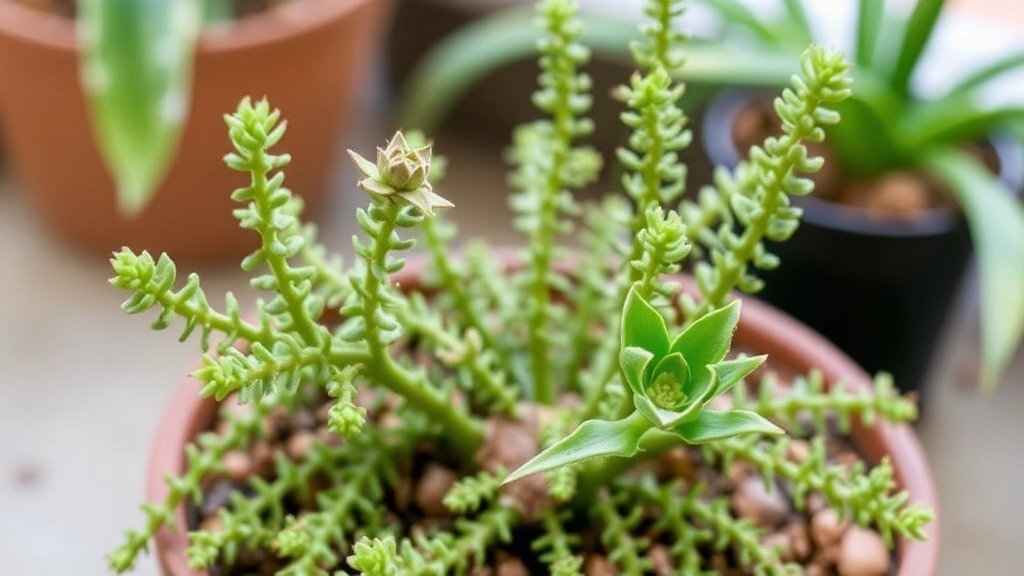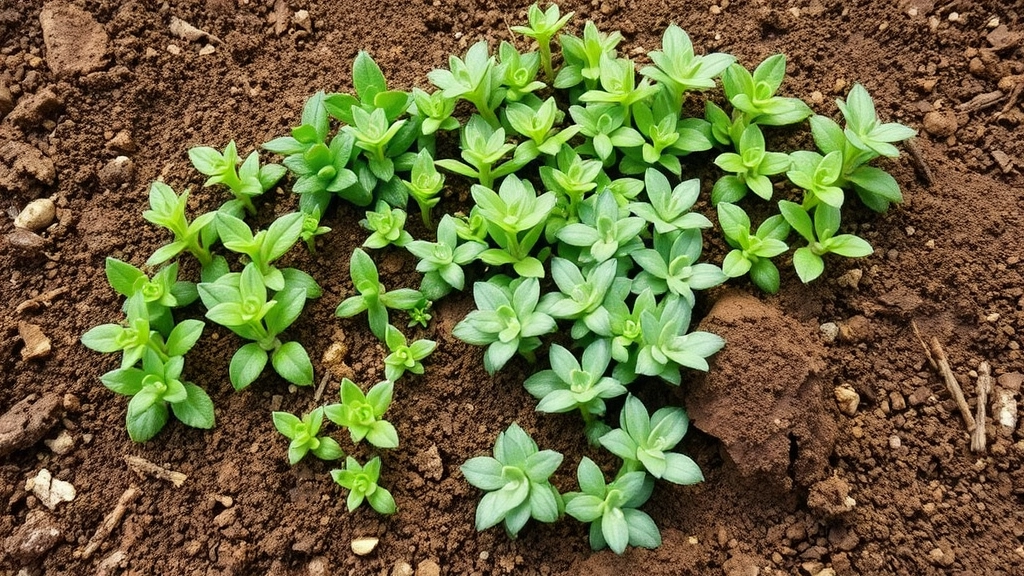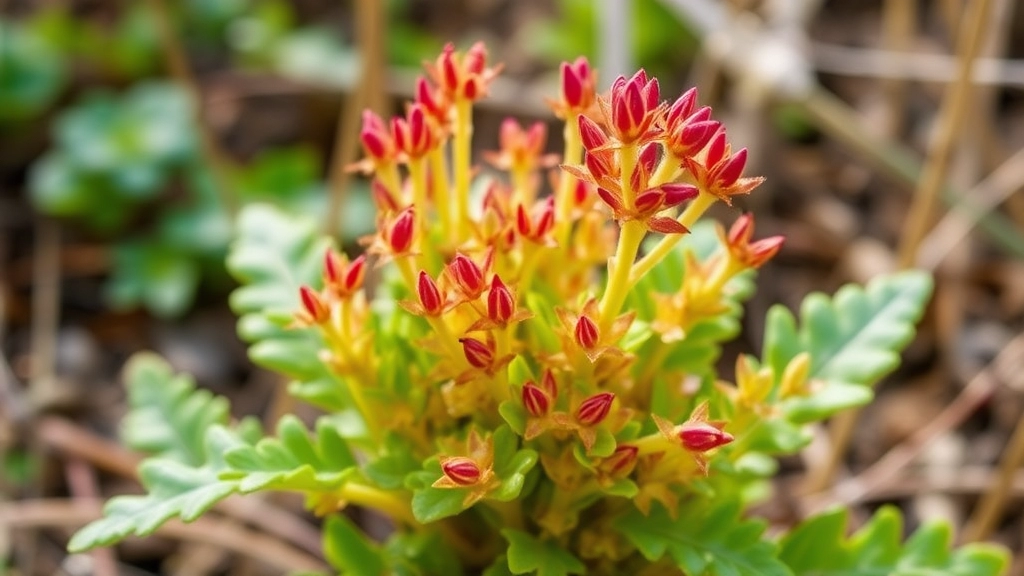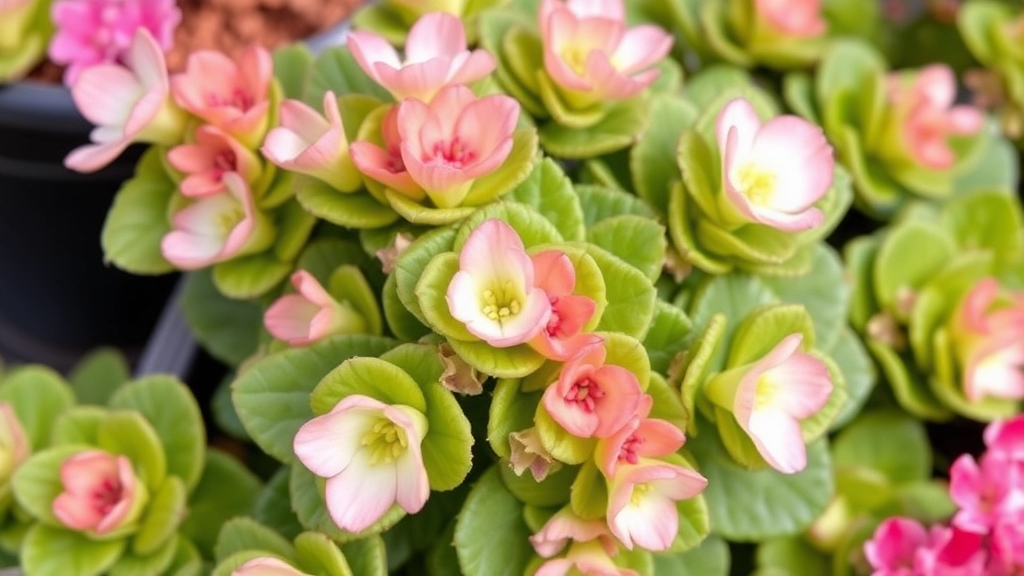Kalanchoe Mother of Thousands Varieties
When it comes to Kalanchoe Mother of Thousands varieties, there’s a lot to explore. Whether you’re a seasoned gardener or a succulent newbie, understanding the different types of this fascinating plant can be incredibly rewarding. From the popular Kalanchoe daigremontiana to the unique Kalanchoe x houghtonii, each variety offers something special. Let’s dive into the world of these intriguing plants and discover their unique characteristics and care requirements.
Propagation and Care
One of the most appealing aspects of Kalanchoe Mother of Thousands varieties is their easy propagation. These plants are known for their ability to produce plantlets along the edges of their leaves, making them a favourite among succulent enthusiasts. However, their invasive nature means they require a bit of attention to keep them in check. Stay tuned as we explore the best practices for growing, managing, and enjoying these captivating plants.
When it comes to Kalanchoe Mother of Thousands, many plant enthusiasts often wonder which varieties are the most popular and how they differ.
Kalanchoe is a diverse genus, but the most well-known variety associated with the “Mother of Thousands” moniker is *Kalanchoe daigremontiana*. This particular species is celebrated for its unique ability to produce tiny plantlets along the edges of its leaves.
### Key Varieties to Explore
– **Kalanchoe daigremontiana**: Often referred to as “Chandelier Plant,” it can grow up to 1 metre tall and is easily identifiable by its elongated, serrated leaves. The small plantlets that form on the leaf edges can be seen cascading down, hence the name “Mother of Thousands.”
– **Kalanchoe tubiflora**: Another popular variety, also known as “Mother of Thousands,” features similar propagation traits but has a more tubular leaf shape. It thrives in similar conditions and produces a striking visual display.
– **Kalanchoe beharensis**: Known as “Felt Bush,” this variety has thicker, felt-like leaves and a more robust structure. While it may not produce as many plantlets, it is still a favourite among collectors.
– **Kalanchoe luciae**: Commonly called “Paddle Plant,” it has distinctive, paddle-shaped leaves that can also produce plantlets. This variety adds a unique aesthetic to any collection.
These varieties each offer their own charm and propagation characteristics, making them appealing choices for both novice and experienced gardeners. For a more detailed guide on how to grow and care for Kalanchoe luciae, check out our [Kalanchoe Paddle Plant Flower Care Guide](https://planthq.org/kalanchoe-paddle-plant-flower-care-guide/). Additionally, if you’re interested in the health benefits and uses of another popular variety, read our article on [Kalanchoe Pinnata Health Benefits and Uses](https://planthq.org/kalanchoe-pinnata-miracle-leaf-health-benefits-uses/).
Key Characteristics of the Mother of Thousands Plant

Have you ever wondered what makes the Mother of Thousands plant so special?
Let’s dive into its standout features.
Distinctive Appearance
The Mother of Thousands, known scientifically as Kalanchoe daigremontiana, is a real eye-catcher.
- Leaf Shape: Its leaves are thick, fleshy, and often have a serrated edge, giving them a unique look.
- Colour: They typically flaunt a vibrant green hue, sometimes with a hint of purple or red on the edges.
- Offsets: The plant is famous for producing tiny plantlets along the edges of its leaves, which is how it gets its nickname.
Growth Habit
This plant is a succulent, which means it stores water in its leaves.
- Height: It can grow up to 3 feet tall, making it a striking addition to any space.
- Spread: It tends to spread out, creating a lush, bushy appearance.
Resilience
One of the best parts? This plant is tough as nails.
- Drought Tolerance: It thrives on neglect, perfect for those of us who might forget to water now and then.
- Pest Resistance: Generally, it’s not prone to many pests, though it’s always good to keep an eye out.
Unique Reproductive Strategy
The Mother of Thousands doesn’t just grow; it multiplies like crazy.
- Offsets: The tiny plantlets can root themselves in the soil, leading to a mini-forest of Kalanchoe if left unchecked.
- Seed Production: While it can produce seeds, the offsets are its primary method of propagation.
Unique Propagation Methods Across Kalanchoe Varieties
When discussing how to grow Kalanchoe, one of the most intriguing aspects is their unique propagation methods. Many plant enthusiasts often wonder how to successfully propagate these resilient plants, especially the Mother of Thousands variety.
Soil and Light Preferences for Mother of Thousands Varieties

When it comes to growing Kalanchoe Mother of Thousands, understanding their soil and light preferences is crucial for healthy growth.
What Soil Do They Need?
Choosing the right soil is essential for the well-being of your Mother of Thousands. Here are the key points to consider:
- Well-Draining Soil: Use a cactus or succulent mix that drains well. This prevents root rot, which is a common issue.
- pH Level: Aim for a slightly acidic to neutral pH (around 6.0 to 7.0). This range supports optimal nutrient uptake.
- Additives: Consider mixing in perlite or coarse sand to improve drainage further.
Light Requirements
Light is another significant factor in the growth of Kalanchoe varieties. Here’s what you should know:
- Bright, Indirect Light: These plants thrive in bright, indirect sunlight. A south or east-facing window is ideal.
- Avoid Direct Sunlight: While they enjoy light, too much direct sun can scorch their leaves.
- Supplemental Lighting: If you’re growing them indoors, consider using grow lights during the winter months when natural light is limited.
By ensuring your Mother of Thousands have the right soil and light conditions, you set the stage for vibrant growth.
Common Challenges in Growing Mother of Thousands
Growing the Kalanchoe Mother of Thousands can be a rewarding experience, but it does come with its own set of challenges.
What issues might you face?
- Overwatering:
- This succulent is prone to root rot.
- Ensure the soil dries out between waterings. For more tips, refer to our Optimal Watering Tips for Healthy Florist Kalanchoe.
- Pest Infestations:
- Watch for mealybugs and aphids.
- Regularly inspect the leaves and stems.
- Inadequate Light:
- Insufficient sunlight can lead to leggy growth.
- Aim for bright, indirect light to keep your plants healthy.
- Temperature Fluctuations:
- Kalanchoe prefers stable temperatures.
- Avoid placing them near drafts or heating vents.
- Invasive Growth:
- Mother of Thousands can spread rapidly.
- Control its growth by removing offsets regularly. Learn more in our How to Grow and Care for Kalanchoe Mother of Thousands guide.
- Nutrient Deficiency:
- Lack of nutrients can cause poor growth.
- Use a balanced succulent fertiliser during the growing season.
By addressing these challenges, you can cultivate a thriving Mother of Thousands plant.
How to Control Invasive Growth of Mother of Thousands

So, you’ve got a thriving Kalanchoe Mother of Thousands, but now you’re wondering how to keep it from taking over your garden or home.
This plant is beautiful, but its tendency to spread can feel a bit overwhelming.
Here’s how you can manage its growth without losing your mind:
- Regular Pruning: Keep those leaves in check. Snip off any unwanted stems and leaves regularly. This helps prevent them from dropping their baby plantlets everywhere.
- Control Container Size: If you’re potting your Mother of Thousands, choose a container that’s not too big. A snug pot limits its growth space, keeping it manageable.
- Limit Watering: Overwatering can encourage rapid growth. Water only when the soil feels dry. This will help slow down its spread.
- Use Barriers: If you’re planting outdoors, consider using physical barriers like garden edging to contain its roots.
- Plant in Isolated Areas: If you’re planting it in the garden, choose a spot away from other plants. This way, if it does spread, it won’t invade your other beloved plants.
- Monitor for Offshoots: Keep an eye out for new plantlets sprouting. Remove them before they take root.
By following these tips, you can enjoy the beauty of your Kalanchoe Mother of Thousands without letting it run wild.
### Best Practices for Potting and Repotting Kalanchoe Varieties
When considering how to pot and repot Kalanchoe varieties, many enthusiasts often wonder about the right techniques and timing. This process is crucial for maintaining the health and vitality of your Mother of Thousands plants.
1. Choosing the Right Pot
- Size Matters: Select a pot that is slightly larger than the current one. This allows room for growth without overwhelming the roots.
- Drainage is Key: Ensure the pot has drainage holes to prevent waterlogging, which can lead to root rot.
2. Selecting the Appropriate Soil
- Well-Draining Mix: Use a cactus or succulent potting mix. These blends typically contain sand or perlite, promoting excellent drainage. For more details, check out the [best soil for Kalanchoe Blossfeldiana](https://planthq.org/best-soil-for-kalanchoe-blossfeldiana-care-tips/).
- pH Level: Aim for a slightly acidic to neutral pH (around 6.0 to 7.0) to support healthy growth.
3. Timing Your Repotting
- Spring is Ideal: The best time to repot Kalanchoe varieties is during the spring when they are actively growing.
- Signs to Look For: If you notice roots growing out of the drainage holes or the plant appears top-heavy, it’s time to consider repotting.
4. The Repotting Process
- Gently Remove the Plant: Carefully take the plant out of its pot, loosening the soil around the roots.
- Inspect the Roots: Trim any dead or damaged roots with clean, sharp scissors. This encourages healthy growth.
- Position Your Plant: Place the plant in the new pot, ensuring the top of the root ball is level with the pot’s rim.
- Fill with Soil: Add fresh potting mix around the roots, pressing gently to eliminate air pockets.
5. Post-Repotting Care
- Water Sparingly: After repotting, wait a week before watering to allow the roots to settle.
- Provide Adequate Light: Place the repotted plant in a bright location, but avoid direct sunlight for a few days to reduce stress. For more expert tips, refer to our [complete care guide for Kalanchoe succulents](https://planthq.org/how-to-care-for-a-kalanchoe-succulent-expert-tips/).
FAQs About Kalanchoe Mother Of Thousands Varieties
What makes the Mother of Thousands plant unique?
The Mother of Thousands, scientifically known as Kalanchoe daigremontiana, is distinctive for its thick, fleshy leaves with serrated edges and vibrant green hue. It is also famous for producing tiny plantlets along the edges of its leaves.
How tall can the Mother of Thousands plant grow?
This succulent can grow up to 3 feet tall, making it a striking addition to any space.
What type of soil is best for Mother of Thousands varieties?
These plants thrive in well-draining soil, such as a cactus or succulent mix. Aim for a slightly acidic to neutral pH (around 6.0 to 7.0) and consider adding perlite or coarse sand to improve drainage.
What are the light requirements for Mother of Thousands?
Mother of Thousands varieties prefer bright, indirect sunlight. A south or east-facing window is ideal. Avoid direct sunlight, which can scorch their leaves, and consider using grow lights during the winter months.
How do I control the invasive growth of Mother of Thousands?
To manage its growth, you can regularly prune unwanted stems and leaves, use a smaller container, limit watering, use physical barriers, plant in isolated areas, and monitor for new plantlets to remove them before they take root.
Is the Mother of Thousands plant drought-tolerant?
Yes, the Mother of Thousands is highly drought-tolerant and can thrive on neglect, making it perfect for those who might forget to water occasionally.
What is the primary method of propagation for Mother of Thousands?
While the plant can produce seeds, its primary method of propagation is through the tiny plantlets that grow along the edges of its leaves. These plantlets can root themselves in the soil, leading to new plants.
Are Mother of Thousands plants resistant to pests?
Generally, Mother of Thousands plants are not prone to many pests, although it is always good to keep an eye out for any potential issues.
References
-
Mother of Thousands Plant: How To Grow Kalanchoe Daigremontiana
-
How to Grow and Care for Mother of Thousands
-
Mother of Thousands – House Plants Expert
